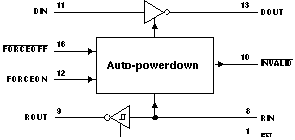SLLS822C July 2007 – December 2024 TRSF3221E
PRODUCTION DATA
- 1
- 1 Features
- 2 Applications
- 3 Description
- 4 Pin Configuration and Functions
-
5 Specifications
- 5.1 Absolute Maximum Ratings
- 5.2 ESD Ratings
- 5.3 ESD Ratings, IEC Specifications
- 5.4 Recommended Operating Conditions
- 5.5 Thermal Resistance Characteristics
- 5.6 Electrical Characteristics
- 5.7 Electrical Characteristics, Driver
- 5.8 Switching Characteristics, Driver
- 5.9 Electrical Characteristics, Receiver
- 5.10 Switching Characteristics, Receiver
- 5.11 Electrical Characteristics, Auto-Powerdown
- 5.12 Switching Characteristics, Auto-Powerdown
- 5.13 Typical Characteristics
- 6 Parameter Measurement Information
- 7 Detailed Description
- 8 Application and Implementation
- 9 Device and Documentation Support
- 10Revision History
- 11Mechanical, Packaging, and Orderable Information
Package Options
Mechanical Data (Package|Pins)
Thermal pad, mechanical data (Package|Pins)
- RGT|16
Orderable Information
3 Description
The TRSF3221E consists of one line driver, one line receiver, and a dual charge-pump circuit with ±15kV IEC ESD protection pin to pin (serial-port connection pins, including GND). The TRSF3221E provides the electrical interface between an asynchronous communication controller and the serial-port connector. The charge pump and four small external capacitors allow operation from a single 3V to 5.5V supply. The TRSF3221E operates at data signaling rates up to 1Mbit/s and a driver output slew rate of 24V/μs to 150V/μs.
Flexible
control options for power management are available when the serial port is inactive.
The auto-powerdown feature functions when FORCEON is low and
FORCEOFF is high. During this mode of operation, if the
TRSF3221E does not sense a valid RS-232 signal on the receiver input, the driver
output is disabled. If FORCEOFF is set low and the enable
(EN) input is high, both the driver and receiver are shut
off, and the supply current is reduced to 1μA. Disconnecting the serial port or
turning off the peripheral drivers causes the auto-powerdown condition to occur.
Auto-powerdown can be disabled when FORCEON and FORCEOFF are
high. With auto-powerdown enabled, the device is activated automatically when a
valid signal is applied to the receiver input. The INVALID
output notifies the user if an RS-232 signal is present at the receiver input.
INVALID is high (valid data) if the receiver input voltage
is greater than 2.7V or less than –2.7V, or has been between –0.3V and 0.3V for less
than 30μs. INVALID is low (invalid data) if the receiver input
voltage is between –0.3V and 0.3V for more than
30μs.
See Figure 6-5 for receiver
input levels.
| PART NUMBER | PACKAGE(1) | PACKAGE SIZE(2) |
|---|---|---|
| TRSF3221E | DB (SSOP) | 6.2mm x 5.3mm |
| PW (TSSOP) | 5mm x 4.4mm | |
| RGT (VQFN) | 3mm x 3mm | |
| SOT-23-THN (DYY, 16) | 4.2mm × 2mm |
 Logic Diagram (Positive Logic)
Logic Diagram (Positive Logic)